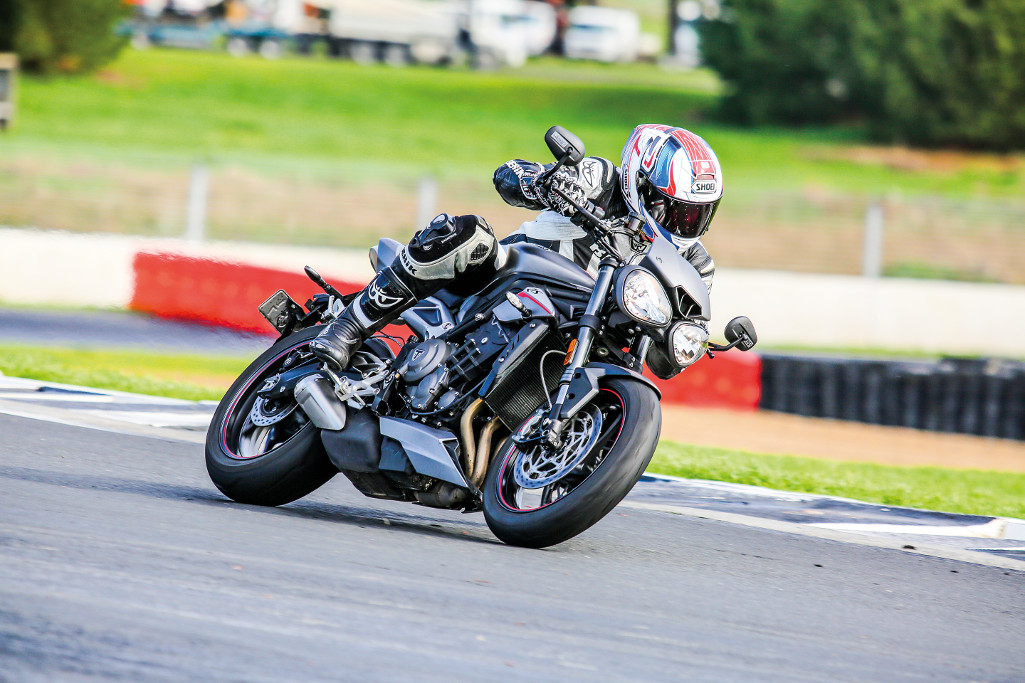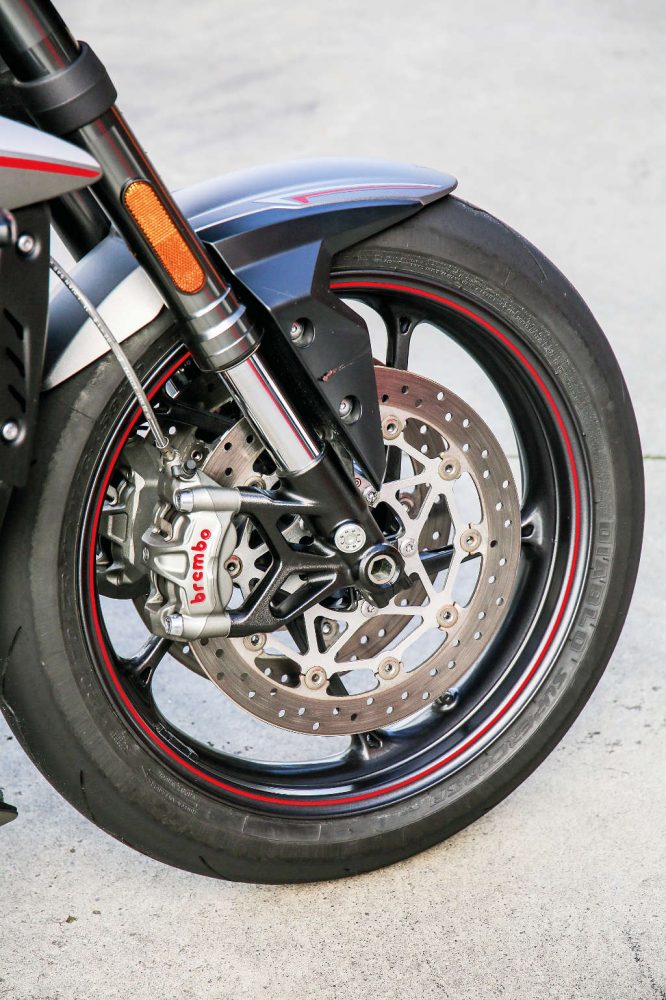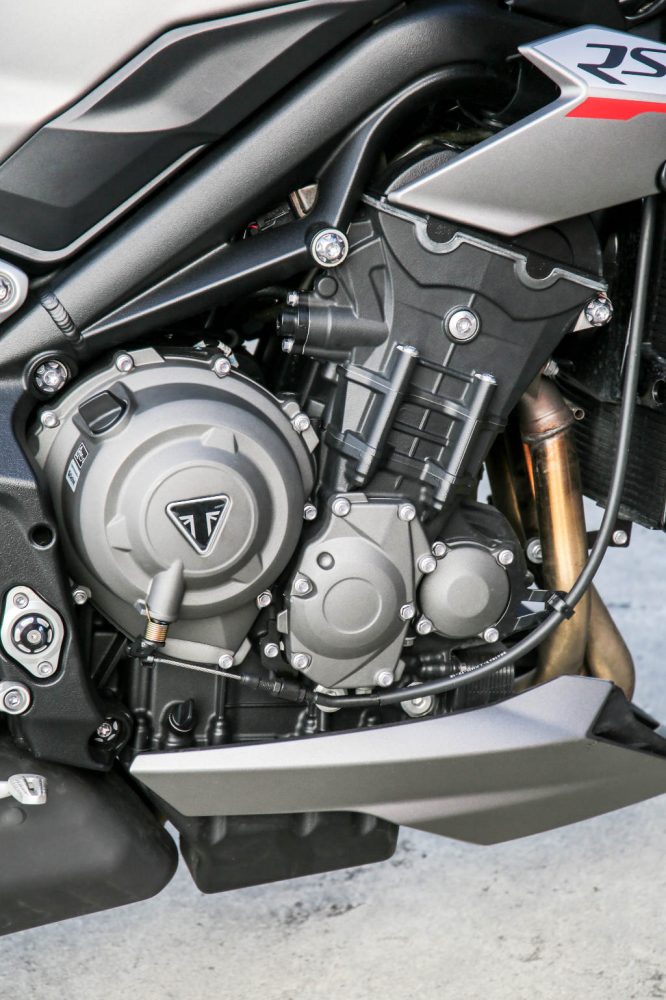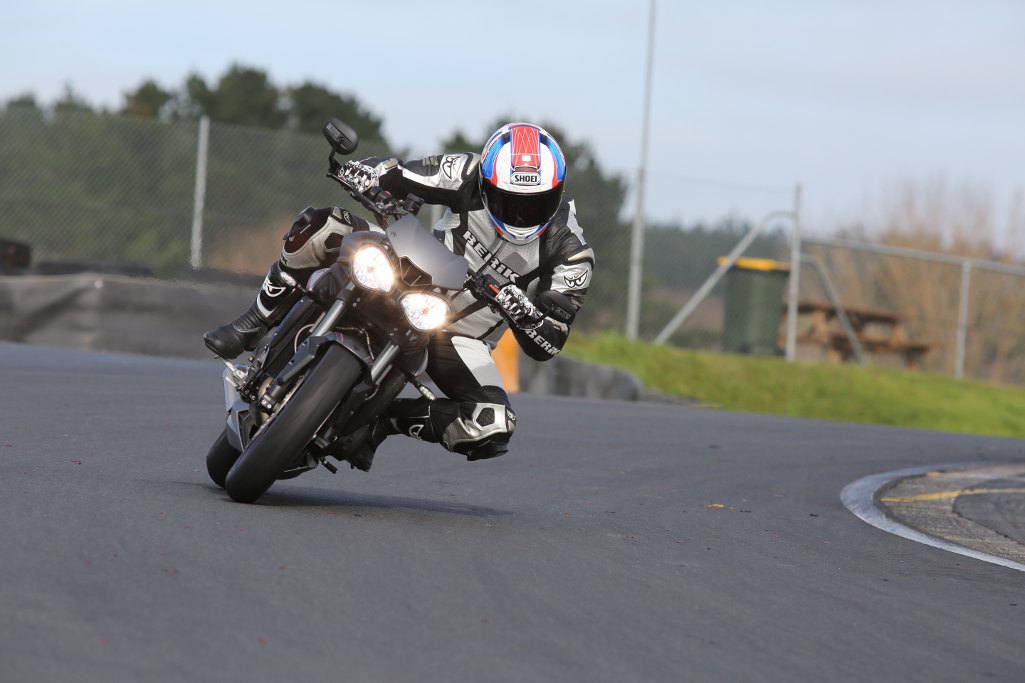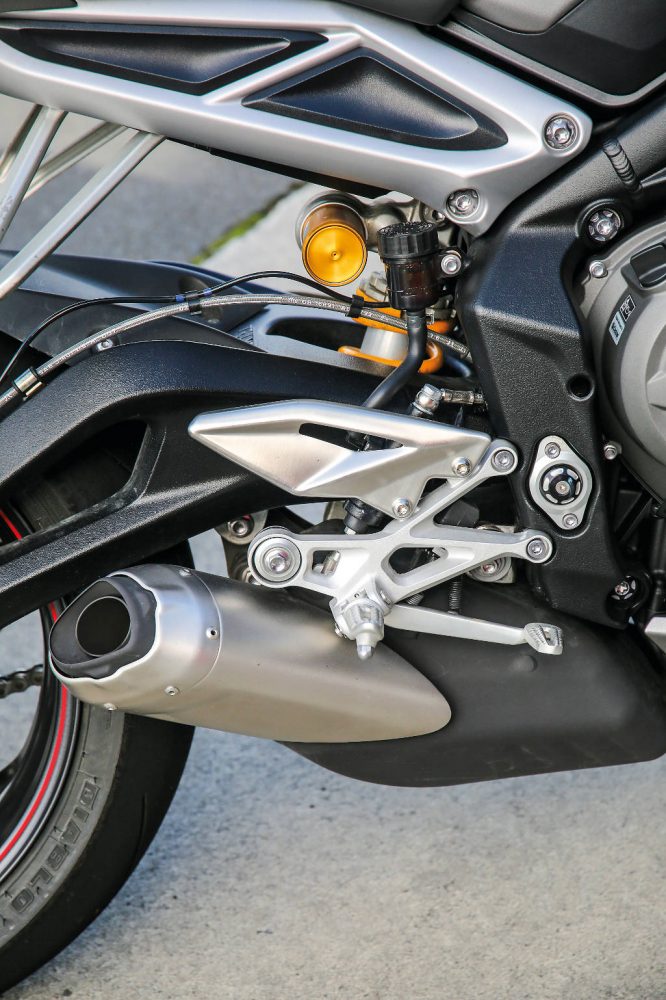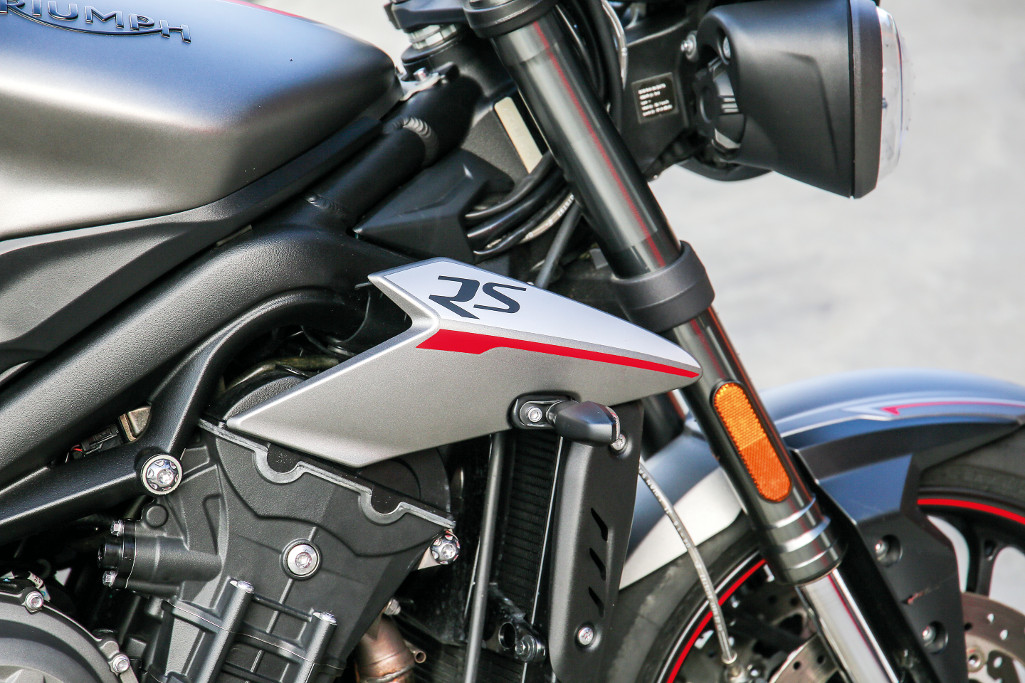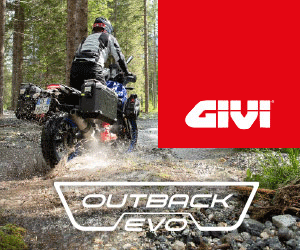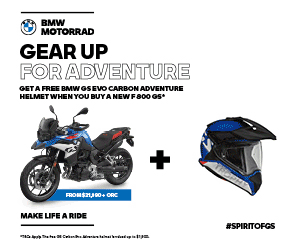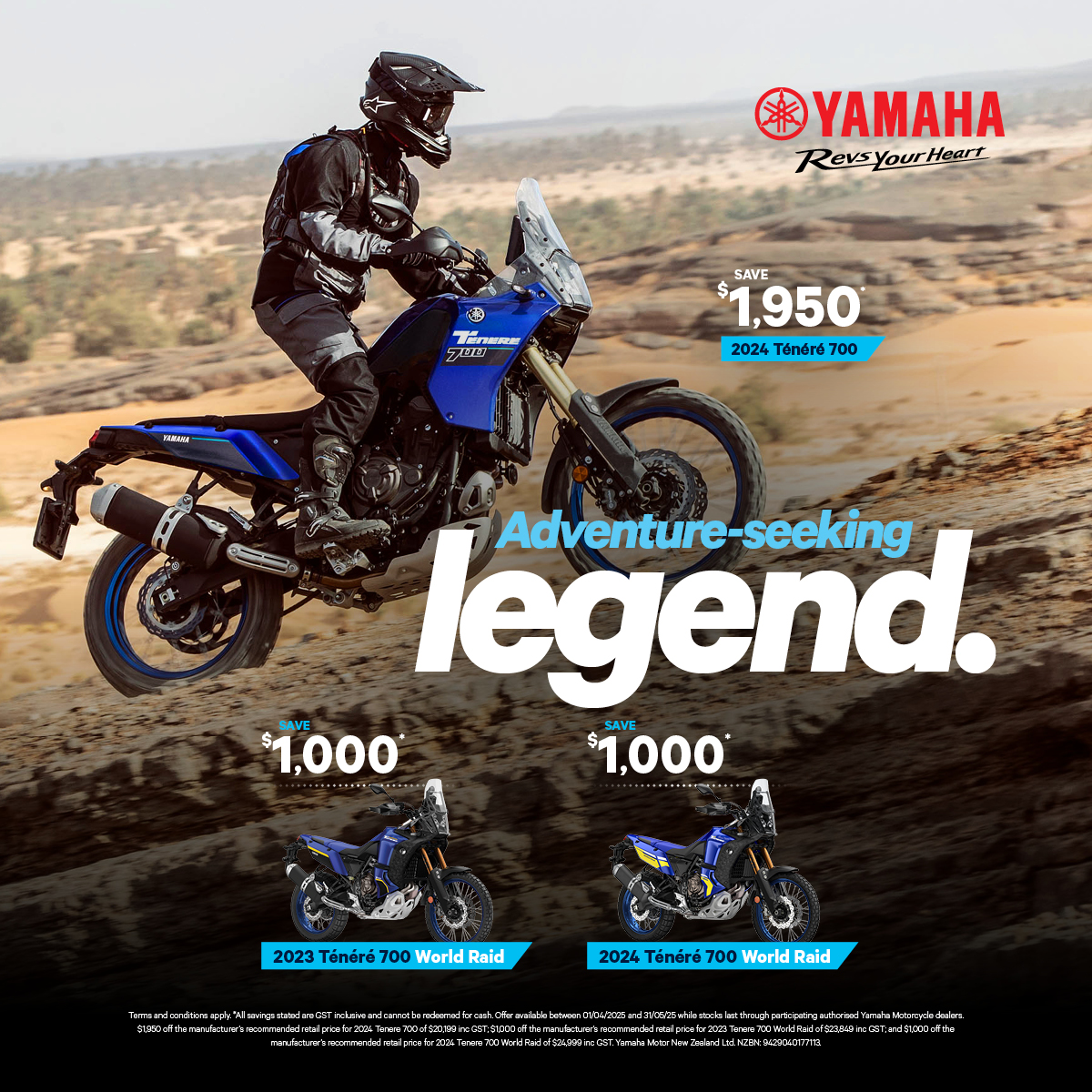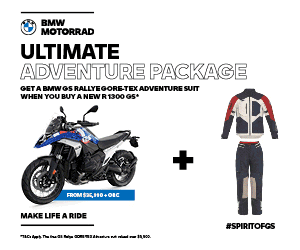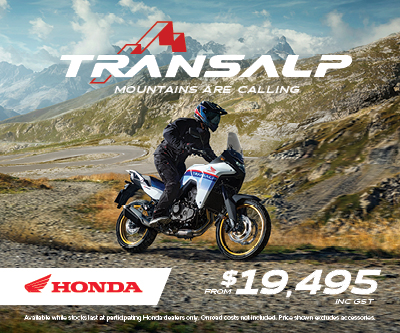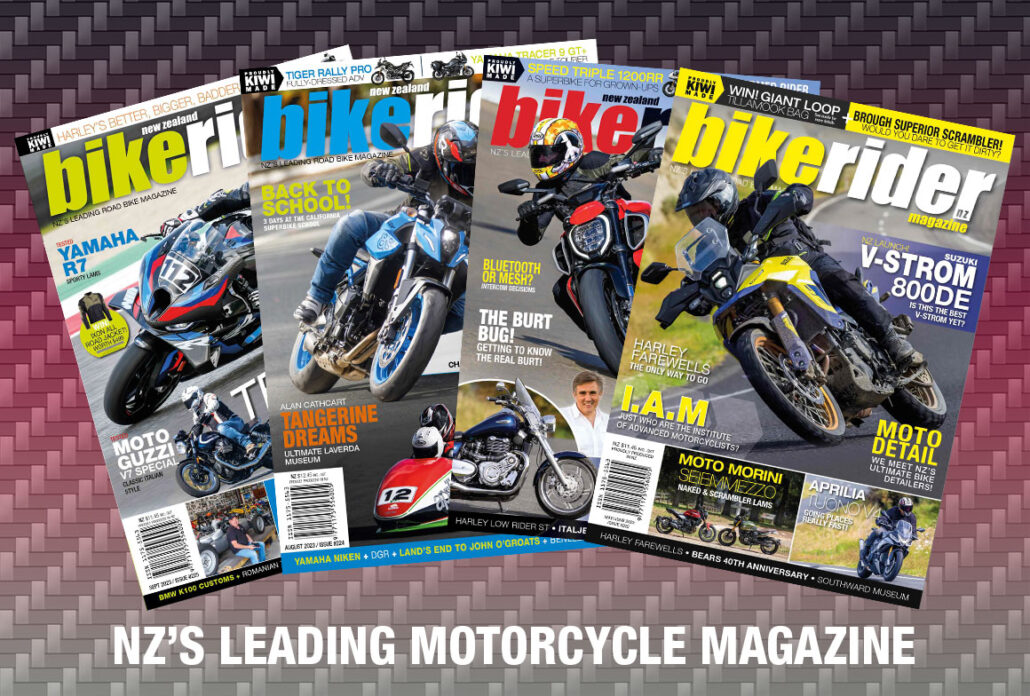Will an increase in capacity, some new technology and top shelf suspension do enough to make the new Street Triple RS worthy of the legendary moniker? Paul hit Hampton Downs and the roads around the Coromandel to find out.
Words: Paul Pics: Kerry
It must be a tough role, getting the job to update the iconic naked Triumph range. With legions of followers around the world who are almost as opposed to change as the Americans are with their V-twins, just swapping the lights from round to square almost brought economic meltdown to the UK and crashed Triumph’s Facebook page for a year. Well, maybe not, but you get the idea…
The Street Triple is Triumph’s middleweight naked, although as is becoming par for the industry, the middleweights are working their way closer to the big boy bikes with each update. The issue is the Euro 4 emission limits which came into force this year (and Euro 5 in 2020). With nobody wanting a bike with less power than the last model but with the manufacturers facing tighter restrictions on pollution, the solution has been to increase capacity in an effort to provide equivalent (or slightly higher) horsepower from a powerplant in a lower state of tune, therefore producing less of the bad stuff.
So, for the Street Triple, that’s meant we’ve now got a middleweight with a capacity of 765cc (only 120cc smaller than the big brother Speed Triple T509 when it was released back in 1997), but it’s meant the British manufacturer has been able to increase output for the RS which we tested by 16% to 121hp and 77Nm of torque. Now, before you get all panicky thinking you’ll never be able to manage a big bike, Triumph has managed to keep the weight low, and even have a low seat variant, with the RS tipping the scales at 166kilos dry. That’s pretty impressive for a bike of this capacity, although having a distinct lack of bodywork has got to make the job easier of keeping the weight down.
Top Spec
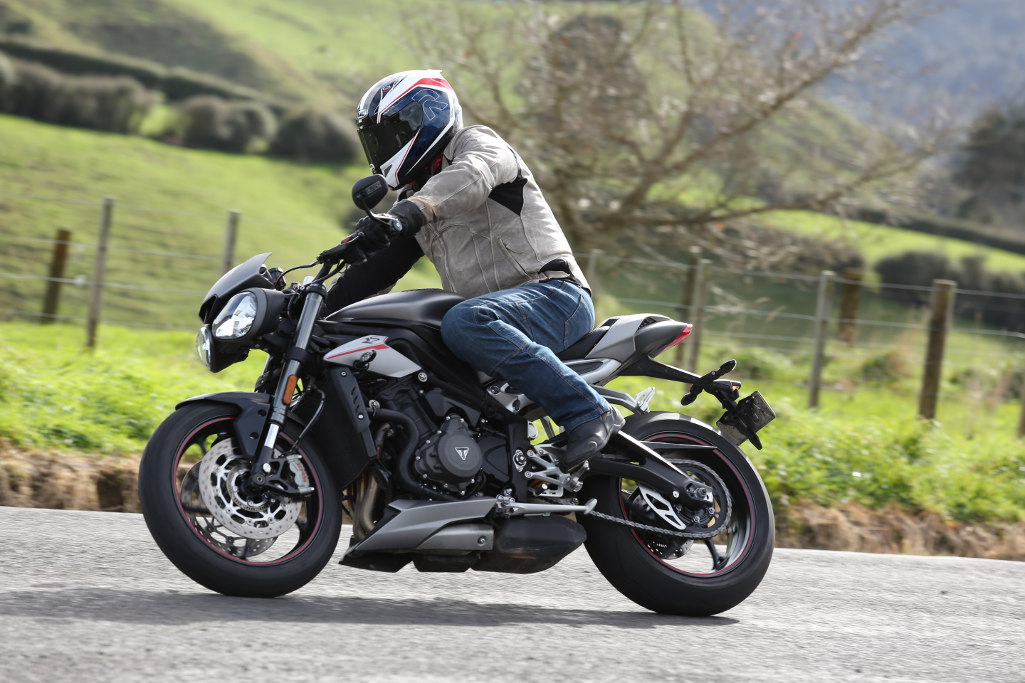 The RS we tested is the flagship model, with four variants available ranging from a LAMS variety which also comes in low seat, to the basic S-model, slightly higher-spec R-model, and topping off with the RS. As you’d expect for a bike which is going to set you back the best part of $21k, the RS is dripping with goodies which include top-spec Showa big piston forks, the latest TFT screen, stunning Brembo M50 monobloc calipers and the highest output powerplant. With over 80 new parts slotted into the triple cylinder motor from the last version, the 2018 Street Triple features new cams and pistons, an increased bore and stroke, Nikasil plated aluminium barrels and an upgraded ECU. The difference is mind blowing and sees the smaller triple producing the same sort of performance and featuring the same hysterical attitude of the original Speed Triple, but more on that later.
The RS we tested is the flagship model, with four variants available ranging from a LAMS variety which also comes in low seat, to the basic S-model, slightly higher-spec R-model, and topping off with the RS. As you’d expect for a bike which is going to set you back the best part of $21k, the RS is dripping with goodies which include top-spec Showa big piston forks, the latest TFT screen, stunning Brembo M50 monobloc calipers and the highest output powerplant. With over 80 new parts slotted into the triple cylinder motor from the last version, the 2018 Street Triple features new cams and pistons, an increased bore and stroke, Nikasil plated aluminium barrels and an upgraded ECU. The difference is mind blowing and sees the smaller triple producing the same sort of performance and featuring the same hysterical attitude of the original Speed Triple, but more on that later.
Before you even fire the engine into life and get to enjoy the throatier voice from the newly designed exhaust and air intake, the dash is enough to take your breath away. Triumph has always managed to keep up-to-date with the latest technology on their new models, but the dashboard and interface has always been dated, clunky and just wrong. So, it was with delight that I saw the new TFT screen light up in front of me the first time I turned the key on the RS. Even without an instruction manual, it took less than 30-seconds to work out what options are available using the 5-way joystick control to cycle through the screens and options. With five rider modes (road, rain, sport, rider, track) available to be toggled through, there’s also the option to independently adjust the ABS and traction control systems which enables you to achieve a truly personal set-up. The ride-by-wire throttle system means that the different options really make a difference to the delivery produced from the triple powerplant, with the throttle response as well as the outright power delivery adjusted with each mode.
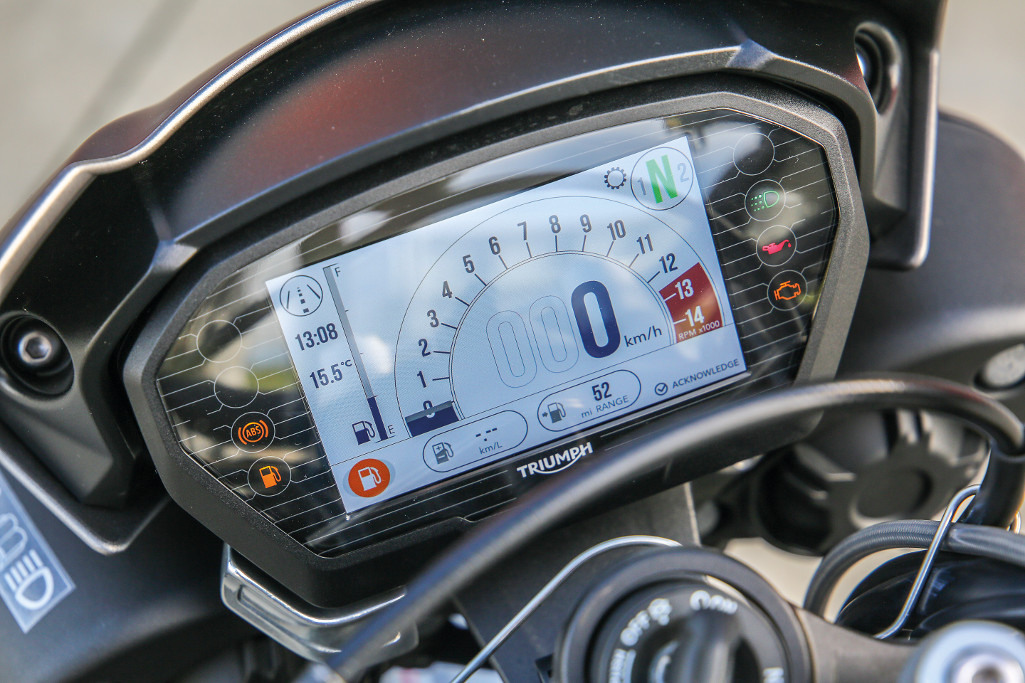 The TFT screen itself is a masterclass of what a motorcycle dashboard should be, with a clear display giving you everything you need to know. The gear indicator is a delight and the three different layout options mean everyone should be able to have the layout they prefer for any situation. On the track at Hampton Downs I opted for the layout which displayed the revs more prominently, while on the road I toggled to the display that had the speed pride of place.
The TFT screen itself is a masterclass of what a motorcycle dashboard should be, with a clear display giving you everything you need to know. The gear indicator is a delight and the three different layout options mean everyone should be able to have the layout they prefer for any situation. On the track at Hampton Downs I opted for the layout which displayed the revs more prominently, while on the road I toggled to the display that had the speed pride of place.
But Triumph didn’t stop there with the changes, and incredibly the bigger capacity Street Triple still hits the scales lighter than the previous version. A new gullwing rear swingarm is stiffer while looking super-trick, while the bodywork has been further refined to keep the Street Triple look, just making it more aggressive.
Bigger Is Better
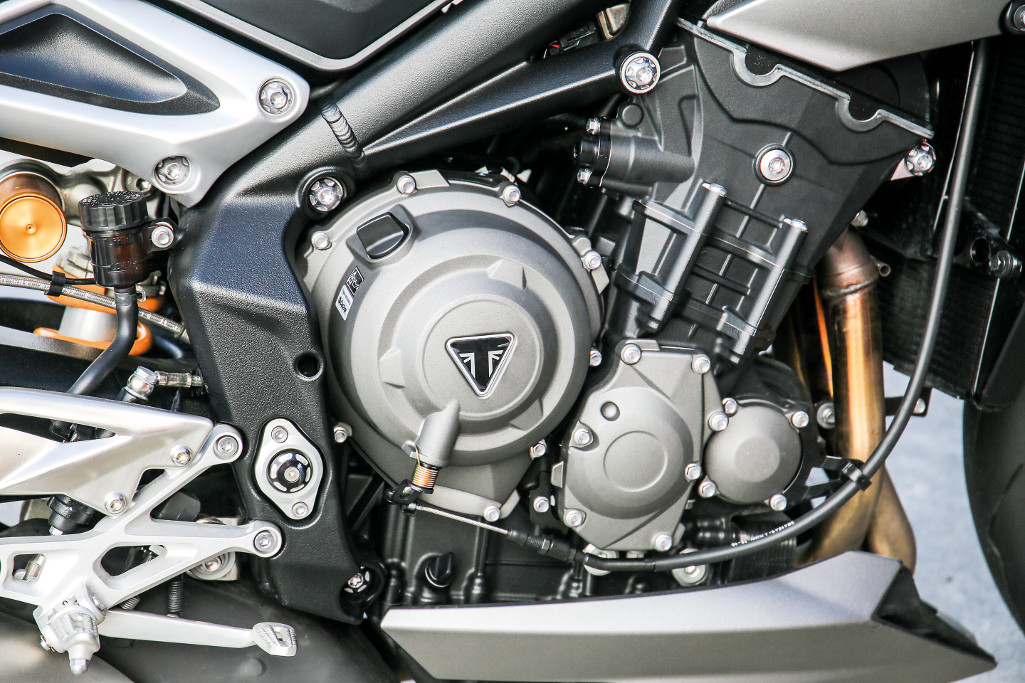 Pulling the RS out of the back of the BRM Mercedes Sprinter at a deserted Hampton Downs was a surreal experience as it’s not often that New Zealand’s premier racetrack isn’t hired out. We were here to test a race bike, with the owner somehow managing to wrangle a private test session on the track. But with the tarmac still drying and the owners a bit nervous about letting me out on their prized racer on slicks in less-than-ideal conditions, I offered to head out on the Trumpy to check the conditions and attempt to dry a line. It was a cheap ploy to get out on track with the RS, but they fell for it, and I didn’t need to be asked twice to get my leathers on and head down pitlane.
Pulling the RS out of the back of the BRM Mercedes Sprinter at a deserted Hampton Downs was a surreal experience as it’s not often that New Zealand’s premier racetrack isn’t hired out. We were here to test a race bike, with the owner somehow managing to wrangle a private test session on the track. But with the tarmac still drying and the owners a bit nervous about letting me out on their prized racer on slicks in less-than-ideal conditions, I offered to head out on the Trumpy to check the conditions and attempt to dry a line. It was a cheap ploy to get out on track with the RS, but they fell for it, and I didn’t need to be asked twice to get my leathers on and head down pitlane.
The new exhaust on the Street Triple makes the Triumph sound like it’s angry even when you’re trundling along in first gear, but it was when I snapped the throttle open in anger for the first time that I simply fell in love with the noise coming from the three cylinder powerplant. The Brits must have a patent on this sound as it’s priceless! Watching the rev counter change to orange on the TFT dash as the bars climbed past 8,000rpm is a neat trick, but you don’t need to be anywhere near this end of the rev range for the Street Triple to be producing useable grunt. From as low as 3,000rpm the flexible 765cc motor will pick up its heals and start driving forward, but it takes until around 5,000rpm for the motor to begin sounding angry and then it’s just pure pleasure and blurring scenery from then on.
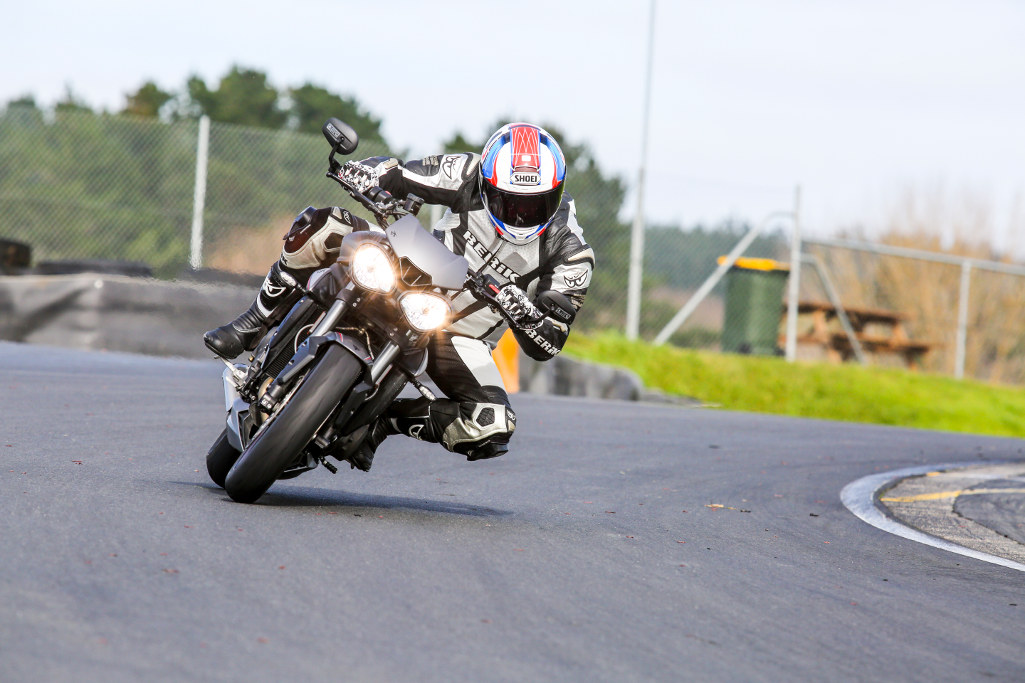 A stunning engine, wide bars, demon brakes and top-shelf suspension is always a great recipe, and as the track slowly dried I began having real fun on the RS. Starting off with the electronics set to intervene early should I get a bit carried away, the second session saw the RS switched to track mode, just with the ABS dialled up a bit to offer me a bit of a safety margin on the drying track. The Brembos offer incredible power but also unrivalled levels of feel, especially with the trick adjustable levers of the Street Triple meaning you can dial in a comfortable setup. The clutch is light enough for one finger use, too, which is courtesy of the slip-and-assist system that not only means there’s no chatter on fast down shifts, but also hooks up harder under acceleration. The engineers can then use softer springs while achieving the same amount of power, meaning less fatigue for a rider.
A stunning engine, wide bars, demon brakes and top-shelf suspension is always a great recipe, and as the track slowly dried I began having real fun on the RS. Starting off with the electronics set to intervene early should I get a bit carried away, the second session saw the RS switched to track mode, just with the ABS dialled up a bit to offer me a bit of a safety margin on the drying track. The Brembos offer incredible power but also unrivalled levels of feel, especially with the trick adjustable levers of the Street Triple meaning you can dial in a comfortable setup. The clutch is light enough for one finger use, too, which is courtesy of the slip-and-assist system that not only means there’s no chatter on fast down shifts, but also hooks up harder under acceleration. The engineers can then use softer springs while achieving the same amount of power, meaning less fatigue for a rider.
The gearbox is another standout piece of the Street Triple puzzle, with the quickshifter offering full throttle upshifts and making the triple cylinder powerplant sound even better. Whether you’re commuting through traffic or on the throttle stop along the start/finish straight at Hampton Downs, the quickshifter just makes life easier and smoother while also meaning you never miss a shift. If you don’t want to use it then simply pull the clutch in and shift as normal. But once you’ve used a quickshifter, you’ll never want to go back.
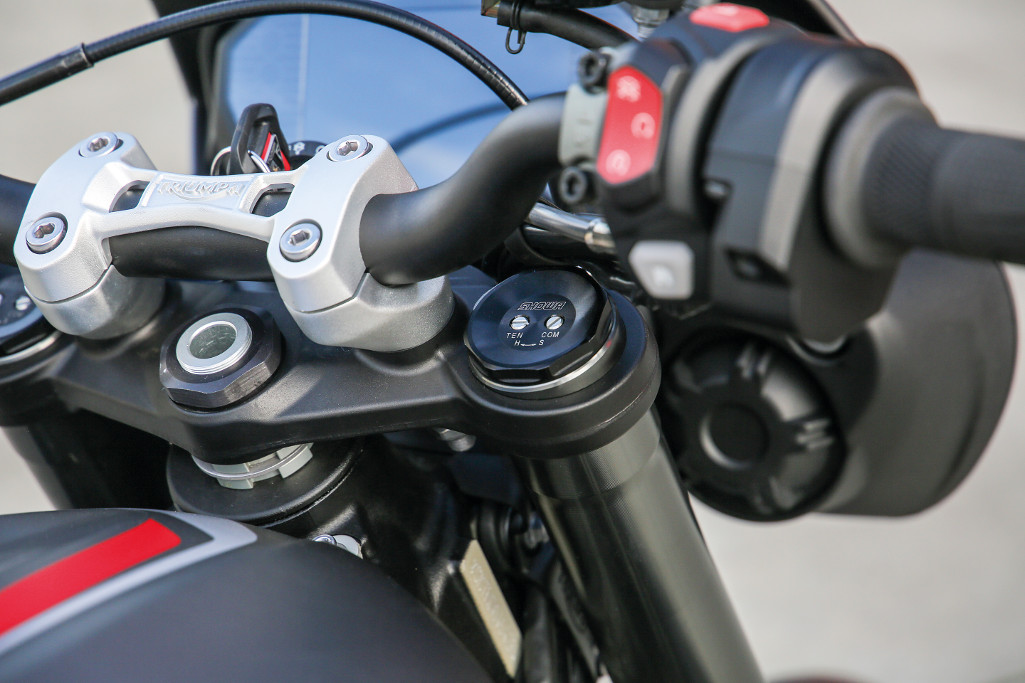 The Showa BFF forks on my quick track test were more than capable of dealing with the punishment I was dishing out and remained composed throughout. They held up well under braking although would probably benefit from a bit of an increase in rebound damping should you be spending the day larking around on the racetrack. The Öhlins STX40 shock in comparison was a little on the comfortable side, which could be a combination of my 98kilos and a road-biased setup requiring a bit of a fiddle with the clickers. Being an Öhlins, there’s plenty of adjustment to play with, but as I was only having a few quick laps before getting on with the real job of riding a race bike, I was going to reserve judgement till I’d sampled the RS in the real world of Kiwi backroads.
The Showa BFF forks on my quick track test were more than capable of dealing with the punishment I was dishing out and remained composed throughout. They held up well under braking although would probably benefit from a bit of an increase in rebound damping should you be spending the day larking around on the racetrack. The Öhlins STX40 shock in comparison was a little on the comfortable side, which could be a combination of my 98kilos and a road-biased setup requiring a bit of a fiddle with the clickers. Being an Öhlins, there’s plenty of adjustment to play with, but as I was only having a few quick laps before getting on with the real job of riding a race bike, I was going to reserve judgement till I’d sampled the RS in the real world of Kiwi backroads.
Fit For The Street
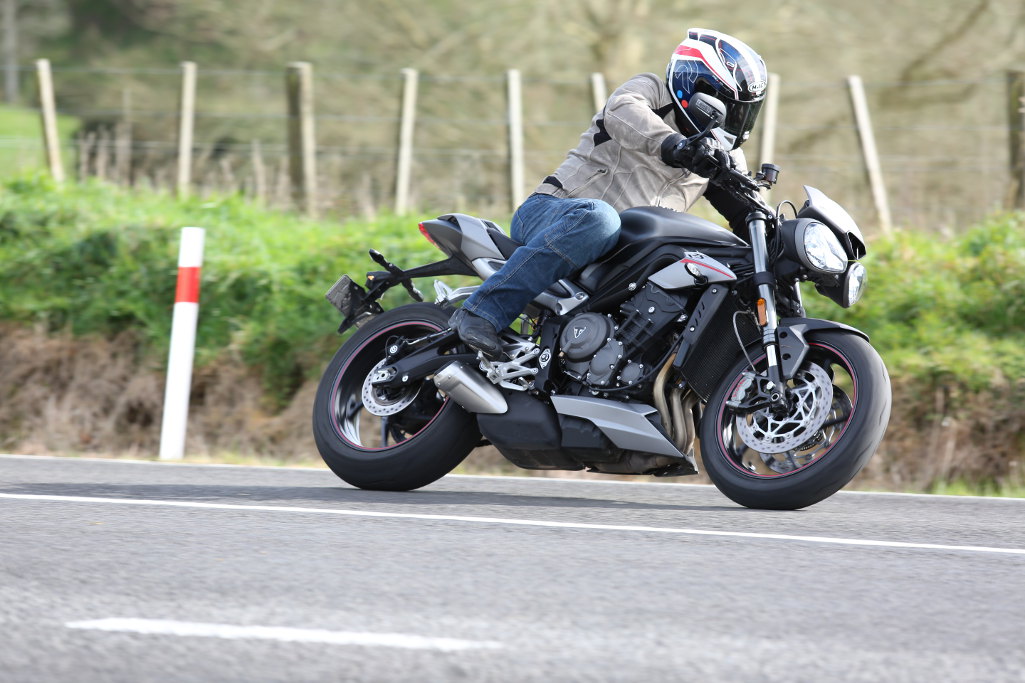 It’s simply a noise I can’t get enough of. Triumph’s triple cylinder howl is so recognisable that it literally makes the hairs on my neck stand to attention, and the Street Triple arguably takes the signature tune to another level. Add the quickshifter into the equation and I couldn’t help jumping up and down the gearbox within the Street Triple’s healthy midrange as I carved through the glorious twists and turns around Whangamata and beyond. As the howl reverberated around the hills, it became a conscious effort not to get too carried away on the Street, with the digital display on the TFT dash able to display some extremely high speeds at an electrifying pace. Despite ‘only’ being a middleweight, the new Street Triple is certainly capable of playing with the big boys, and in the right hands it’ll be untouchable around your favourite street circuit.
It’s simply a noise I can’t get enough of. Triumph’s triple cylinder howl is so recognisable that it literally makes the hairs on my neck stand to attention, and the Street Triple arguably takes the signature tune to another level. Add the quickshifter into the equation and I couldn’t help jumping up and down the gearbox within the Street Triple’s healthy midrange as I carved through the glorious twists and turns around Whangamata and beyond. As the howl reverberated around the hills, it became a conscious effort not to get too carried away on the Street, with the digital display on the TFT dash able to display some extremely high speeds at an electrifying pace. Despite ‘only’ being a middleweight, the new Street Triple is certainly capable of playing with the big boys, and in the right hands it’ll be untouchable around your favourite street circuit.
With Triumph describing the new look of the Street Triple as having a ‘nose down focused attitude’, I couldn’t help feeling that the Triumph offers slightly less wind protection than previously. I know that sounds weird as the RS is a naked bike, but you still usually get a certain amount of respite from the wind blast through the lights and bikini fairing deflecting the air. But the Street Triple seems to have been designed to give you the full effect of riding a naked, with a decent blast there at open road speeds. Obviously, that has the bonus of keeping the weight off your hands while also keeping your speed down (which you need on a bike like this), but if there’s the option of an accessory screen, I’d be tempted to get it if you ride for longer than a Sunday morning scratch to the café.
Re-birth Of A Legend
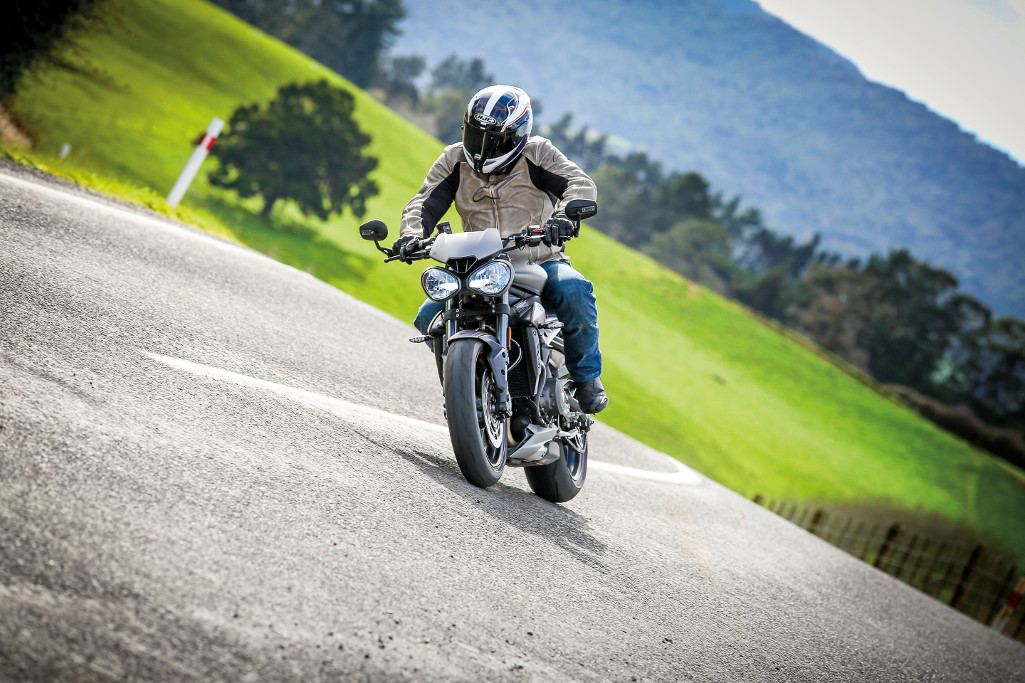 Despite the climb in capacity and gain in horsepower, the Street Triple has still managed to retain its title of the lightest in its class, a trick that will have the competition scratching their heads. Like a bike born in Italia that comes with a certain character, the Street Triple has managed to take the Street Fighter genre, mix it with the best of British and amplified everything by 50%. But that’s not to say it’s quirky or relying on its heritage to make riders overlook inadequacies. The Street Triple is a stunning motorcycle and undoubtedly the best incarnation, not only of the middleweight Street range, but also the big brother Speed Triple family. The way Triumph have managed to produce a supremely lightweight package that changes direction with lightning reflexes and mix it with a powerplant that has character by the bucket load yet is so composed is a monumental achievement. The RS is just as happy trundling through town in top gear as it is bouncing off its rev limit on a racetrack. Achieving either one well is good, but managing both in the same package is incredible.
Despite the climb in capacity and gain in horsepower, the Street Triple has still managed to retain its title of the lightest in its class, a trick that will have the competition scratching their heads. Like a bike born in Italia that comes with a certain character, the Street Triple has managed to take the Street Fighter genre, mix it with the best of British and amplified everything by 50%. But that’s not to say it’s quirky or relying on its heritage to make riders overlook inadequacies. The Street Triple is a stunning motorcycle and undoubtedly the best incarnation, not only of the middleweight Street range, but also the big brother Speed Triple family. The way Triumph have managed to produce a supremely lightweight package that changes direction with lightning reflexes and mix it with a powerplant that has character by the bucket load yet is so composed is a monumental achievement. The RS is just as happy trundling through town in top gear as it is bouncing off its rev limit on a racetrack. Achieving either one well is good, but managing both in the same package is incredible.
The Street Triple RS is undoubtedly the most surprising and rewarding motorcycle I’ve ridden so far this year. While I was expecting something down-spec and just not quite as good or fun as its bigger brother, instead I found a bike which could run rings around not only the bigger bikes but also pretty much anything else in the class. The only niggle in the back of my mind was, what’s coming with the Speed Triple? If Triumph manages the same tricks with the bigger bike, it will be an incredible success. But will the same increase in capacity combined with more power make the bigger bike simply too much? Well, some will say you can never have too much. The fact is, with the Street Triple RS, Triumph has arguably produced a motorcycle with the perfect combination of power, weight, size and agility. One thing is for sure, this is without doubt the best motorcycle to come out of the Hinckley factory to date.
2017 Triumph Street Triple RS
Price: $20,990 + ORC
Engine type: 765cc, Liquid-cooled, 12 valve, DOHC, in-line 3-cylinder
Bore x Stroke: 77.99mm x 53.38mm
Compression: 12.65:1
Carburation: Multipoint sequential electronic fuel injection with SAI. Electronic throttle control
Exhaust: Stainless steel 3 into 1 exhaust system low single sided stainless steel silencer
Max Power: 121.2hp (90.4 kW) @ 11,700rpm
Max Torque: 77Nm @ 10,800rpm
Final drive: O ring chain
Clutch: Wet, multi-plate, slip-assisted
Gearbox: 6-speed
Frame: Aluminium beam twin spar
Swingarm: Twin-sided, cast aluminium alloy
Front Wheels: Cast aluminium alloy 5-spoke 17 x 3.5-inch
Rear Wheels: Cast aluminium alloy 5-spoke 17 x 5.5-inch
Front Tyres: 120/70ZR17
Rear Tyres: 180/55ZR17
Front Suspension: Showa 41mm upside down big piston forks (BPF), 115mm front wheel travel. Adjustable compression damping, rebound damping and adjustable preload
Rear Suspension: Öhlins STX40 fully-adjustable piggyback reservoir RSU, 131mm rear wheel travel.
Brakes Front: Twin 310mm floating discs, Brembo M50 4-piston radial monobloc calipers, switchable ABS
Brakes Rear: Single 220mm fixed disc, Brembo single piston sliding caliper, switchable ABS
Instruments: Full-colour, 5-inch TFT instrument pack with 2x Themes, 3x styles and high/low contrast options
Width Handlebars: 735mm
Height: 1085mm
Seat Height: 825mm
Wheelbase: 1410mm
Dry Weight: 166kg
Tank Capacity: 17.4-litres
Fuel Consumption: 4.7l/100km (claimed)

